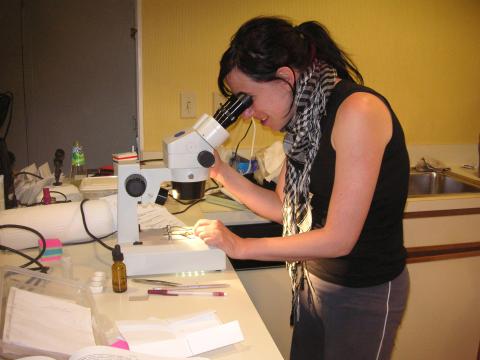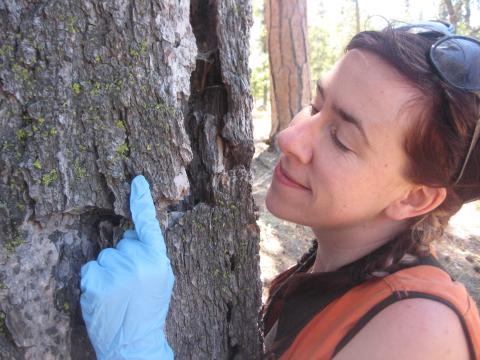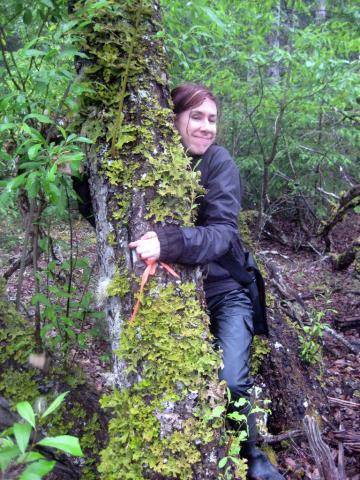Every month, USDA shares the story of a woman in agriculture who is leading the industry and helping other women succeed along the way. This month, we are proud to share the story of Sarah Jovan, a Research Ecologist with the U.S. Forest Service in Portland, Oregon. Sarah, along with her colleague Geoffrey H. Donovan, is a 2017 Finalist for the Promising Innovations Medal of the Samuel J. Heyman Service to America Medals (also known as the “Sammies”). Together, they led the first-ever study using tree moss to detect air pollution in a major city, including cancer-causing heavy metals, prompting enforcement actions and offering a new, cost-effective way to identify threats to public health. Read their full story.
The Sammies highlight excellence in our federal workforce and inspire other talented and dedicated individuals to go into public service. Named for the Partnership for Public Service’s late founder who was inspired by President Kennedy’s call to serve in 1963, these awards align with his vision of a dynamic and innovative federal workforce that meets the needs of the American people. Known as the “Oscars” of government service, they are a highly respected honor with a vigorous selection process. Honorees represent the many exceptional federal workers who are breaking down barriers, overcoming huge challenges and getting results. Learn more and read other honoree bios.
The USDA Women in Ag Initiative is proud to have Lilia McFarland, a former Sammie finalist, on our team and coordinate this interview of Sarah. Lilia was honored as a 2016 Call to Service Finalist for leading an interagency initiative to help build the next generation of farmers and ranchers, creating a strategy for easing access to critical federal resources and improving customer service. Read Lilia’s Story.
LILIA: What was your journey to begin working at the U.S. Department of Agriculture (USDA)?
SARAH: Ever since college I’ve been enthralled with the funky little forest inhabitants, like lichens, moss, and fungi, that people tend to overlook. I spent a semester abroad in the temperate rainforests of Vancouver Island, B.C., where these enigmatic organisms carpet the ground and trees. I came back obsessed! After graduation I moved to the Pacific Northwest and took several temp jobs as a Forest Service field technician. That time was definitely a highlight of my life – hopping around the beautiful Cascades and Coast Ranges, getting PAID to survey for rare mushrooms, lichens and moss. Every day felt like a treasure hunt. I worked with many dedicated Forest Service employees and came to love the nature-loving, down-to-earth culture of the agency. After that, the stars sort of aligned in the best way possible. Turns out, the Forest Service runs a national inventory of lichens and they were looking for a PhD student to study how to use the data for indicating air quality effects on forests. After graduate school, the Forest Service’s Pacific Northwest Research Station took me on as a post-doc and eventually hired me as a research scientist. Now I run the National Lichen Monitoring Program and also dabble in using moss and lichen for mapping air quality in urban areas. I couldn’t be happier career-wise.
LILIA: You and your colleague Geoffrey Donovan are being honored as 2017 finalists for the Samuel J. Heyman Promising Innovations Medal for your work to lead the first-ever study using tree moss to detect air pollution in a major city, including cancer-causing heavy metals, prompting enforcement actions and offering a new, cost-effective way to identify threats to public health. What does public service mean to you?
SARAH: We are so flattered to be Sammies finalists! I find public service incredibly satisfying. In my research developing lichen and moss indicators of air quality, I always have the sense of making a contribution to forest health and society in general, which is the heart of what public service means to me. Knowing the status of our natural resources is critical for informed and effective decision-making about their use and management. Benefits to the public may be dramatic and obvious (like, discovering a pollution problem where people live) or scientific and abstract (designing a new pollution detection approach) or less tangible (but still relevant in the grander scheme of things, like providing data that change how a manager looks at the land he or she is in charge of).
LILIA: What do you wish people knew about USDA and public service?
SARAH: When I look around me, I see a group of extremely hard-working, dedicated people. That story isn’t often told so I’m really appreciating the Sammies public service awards for showcasing examples of creative government research with clear benefits for the public good. As for being a USDA employee, I’ve always felt well treated and taken care of. When major life events arise, I’ve been accommodated and supported. The culture of equal opportunity and valuing diversity is something I greatly respect. As a scientist, I’ve been allowed the freedom to innovate, to take risks (that fail sometimes), and to think for myself. It’s a great place to work…
LILIA: What advice do you give to other creative and aspiring research ecologists about both your path into public service and your path into the USDA?
SARAH: I think what benefitted me most was being patient and relentless in pursuing my research goals. The path to a permanent position as a government scientist rarely seems clear and linear – expect to spend time in many temporary positions, as a post-doc, or fellow, as you develop rapport and determine how to align your goals with program needs. As with any public service job, you need to be very clear in demonstrating the benefits of your research agenda. The art of boiling down a complex study into its key points to engage a diverse audience is something I still struggle with. You’ve got to figure out how to frame your study’s story in an engaging way while staying true to the science and its limitations.
LILIA: As a women in ag, what does a typical day look like for you?
SARAH: As a researcher, there really isn’t a typical day…it all depends on the project you’re focusing on at the moment. In general, most days include answering a barrage of emails to keep the wheels turning with colleagues and at least a little precious time gazing at lichens and moss. Other tasks include forging new collaborations, designing studies, conducting field work, managing contractors, writing papers, sharing results at conferences, and finding time to just think about and connect the dots of the latest mystery we’re working on.
LILIA: Who are your role models? What inspires you?
SARAH: The person who inspires me the most is my father, for many reasons, but most especially, I look up to his resilience in the face of adversity. He struggles daily with serious long-term health issues yet no matter what hurdle is thrown in his way, he marches forward, finding some reason to smile and value each and every day. He manages to stay empowered. It’s remarkable and I aspire to that.
LILIA: What are you reading right now?
SARAH: I just finished re-reading one of my favorites, a bizarre sci-fi classic written in 1985 by Haruki Murakami called “Hard Boiled Wonderland and the End of the World.” It’s a cyber-punk story that mixes parallel realities with different layers of the protagonist’s consciousness. It’s really, really out there. I’m definitely a sci-fi nerd. With a day job that’s all about trying to describe reality as it is, I guess I find balance in my off-time by thinking about wild ideas and stories.
To learn more and connect with other women leaders in agriculture across the country, we encourage you to visit newfarmers.usda.gov/women-in-ag. If there is a leading woman in agriculture you’d like to see on the blog, please send us your suggestions at agwomenlead@usda.gov.



